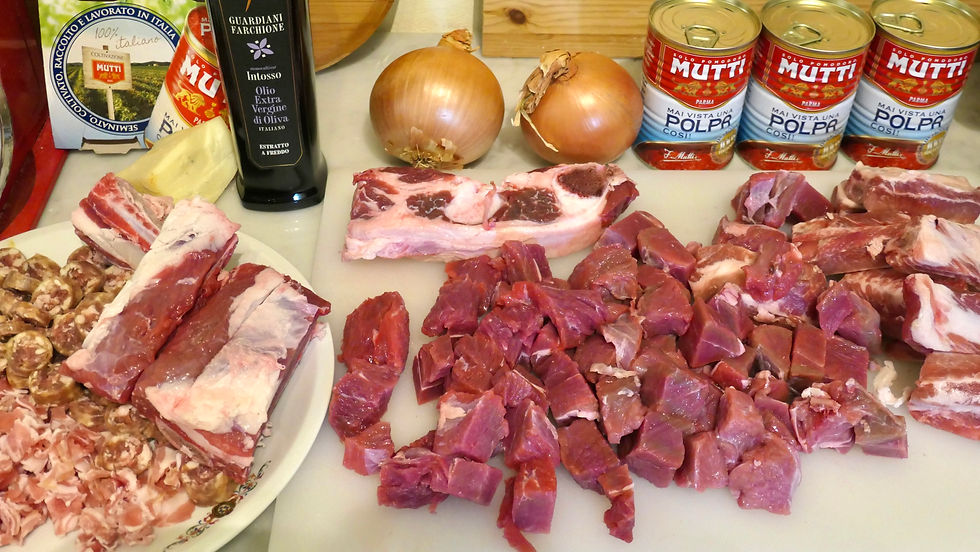24 hour sourdough pizza
- Mike
- Jun 29, 2023
- 3 min read
Updated: Apr 24, 2024

Probably the last thing anyone wants to read is yet another pizza dough recipe but this 24 hour sourdough pizza base is what consistently works for us and as Lucca is not exactly the pizza capital of Italy we can often make better pizza at home than those available locally, notwithstanding the limitations of a domestic oven. We use a Mount Etna lava rock pizza stone which works really well for all kinds of bread as well as pizza.
The long fermentation time facilitated by the use of lievito madre (sourdough starter) together with the inclusion of durum wheat flour makes for a very light and digestible pizza. And as I’m only ever cooking for Italians, it needs to be good or they would be quick to complain!
Ingredients for 4 pizze to fit a 14” diameter pizza stone:
680 grams flour consisting of:
280 grams re-milled (remacinato) durum wheat flour (14% protein)
200 grams tipo ‘1’ soft wheat flour macina a pietra (12% protein)
200 grams multicereali bio, most of which is tipo ‘0’ manitoba soft wheat flour and the rest soft wheat flour of various grains (13% protein)
450 grams water
180 grams lievito madre (bubbling and ready to use)
20 grams extra virgin olive oil
13 grams salt

The final dough has an average protein level of 13.2% and divided by four will produce a dough size of about 330 grams for each pizza. Also the hydration percentage of the dough at the start is exactly 70% assuming the lievito madre is fed with 50/50 flour and water, ie. ((450+90) ÷ (680+90) = 0.7)
Directions:
1. Autolyse, ie. mix the flour and water and leave to rest for 30 mins.
2. Add the lievito madre, olive oil and salt and mix well, then rest for 30 mins.
3. Stretch and fold the dough several times and rest again for about 45 mins.
4. Repeat step 3 and then leave in a cool place overnight (but not fridge cold) until doubled in size.
5. Gently ease the dough out of the bowl onto a floured surface and divide into 4 equal pieces.
6. Shape each piece into a ball using the normal tuck and fold method and tighten them.
7. Place on a lightly floured tray with a dab of olive oil on each one, cover with plastic wrap and put in the fridge for several hours (or up to two days ) until ready to make pizza.
8. Pre-heat the oven on maximum with a pizza stone inside for at least 45 minutes
9. Unlike with bread making, flour is your friend when stretching out the pizza dough so use a generous amount of semola flour and lightly press both sides of the dough into the flour so you can stretch it out on the counter with your fingers without it sticking.
10. This pizza dough will be like a soft cloud with plenty of air inside so the goal is to gently push the air from the center to the rim and pat down the middle with the palm of your hand.
There is no need with this dough to try anything fancy like twirling it in the air to achieve an air filled border that will expand in the oven in the real Neapolitan pizza style.
11. Place the stretched pizza dough onto a well-floured peel ready for the toppings and make sure it can slide around freely without sticking. A thin metal peel works best


We like to use a thickish passata (like the densa and corposa one from Agromonte in Sicily) but spread out quite thinly on the pizza dough, followed by grated parmigiano and evenly sized chunks of mozzarella and a drizzle of olive oil.
Using a pastry brush, paint olive oil around the entire border of the pizza.
It takes about 11-12 minutes in our oven at a max temp of 240 degrees celsius
Notes:
1. The relatively high hydration of this pizza dough is necessary when using a domestic oven because of the longer cooking time. In a real pizza oven 60-63% would be more normal
2. The flour combination we use has quite high protein which absorbs more water, another reason to start with a slightly wetter dough.
3. If we’re adding things like arugula, basil or cured meats like prosciutto, strolghino etc we add them when the pizza has only one or two minutes of cooking time left or preferably add the basil to the finished pizza.
4. Strange though it sounds it’s best to cut the pizza with large kitchen scissors rather than a knife.




